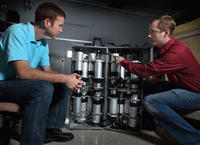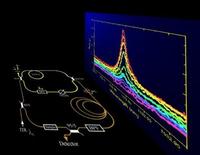-
Mental-health apps may reduce number of mass shooting events
Between 1982 and 2011, mass shootings occurred every 200 days on average. S since 2011, mass shootings have occurred every sixty-four days on average. Mass shootings have one thing in common: the culprits all suffered from mental illness and the condition was known to at least one person. New mobile app educates the public about mental illness and provides local and national resources for early intervention and treatment.
-
-
Sandia Lab’s mobile neutron imager shines in urban emergency response exercise

A nuclear device has been hidden in a high-rise building in a major metropolitan area. Emergency responders have intelligence that narrows down the location to a single city block, but it is not safe to search door-to-door. Can they identify the exact location of the device quickly without the culprits realizing a search is on? The answer is a definite yes. Sandia Lab’ mobile imager of neutrons for emergency responders (MINER) system did just that at an emergency response exercise in downtown Chicago earlier this year. The exercise used a sealed laboratory radiation source that mimics the radioactive signature of more nefarious material.
-
-
New smart key software enhances security for homes businesses
Computer scientists and security specialists have created an innovative electronic smart key system that aims to provide a safer and more flexible security system for homes and businesses. eLOQ is a new software system for the creation and management of electronic keys and locks which cannot be copied or picked.
-
-
Students point to future of ocean robotics in new global game
College students from around the world demonstrated they could have a hand in shaping the future of ocean robotics as they competed in the first Maritime RobotX Challenge, which was held 24-26 October in Singapore. “Developing autonomy for surface vessels is still in its early stages, and these students have the opportunity to come up with solutions that could set new standards in this field,” said Assistant Chief of Naval Research Capt. Rob Palisin, who helped judge the competition. “In turn, the Navy gets the chance to observe the best young engineers in action and learn from their approaches.”
-
-
Next-generation technology for first responders: intuitive, instinctive, and interoperable
DHS’s Science and Technology Directorate (S&T) has a vision for a new age of first responders, a vision which will enable first responders and their technology to be more intuitive, instinctive, and interoperable.TheNext-Generation First Responder suit will incorporates wearables, the Internet, and cellular connectivity, along with multiple environmental and biological sensors to help firefighters, law enforcement, and aid workers, better perform their jobs safely.
-
-
Light frequencies help sniff out deadly materials from a distance

Spectroscopic chemical sensing, which measures the frequency of light absorbed or scattered from a substance to help determine its molecular identity, can be used to detect traces of biological and chemical agents and residue from explosive materials. New program aims to develop chip-sized, optical frequency combs which accurately identify even tiny traces of dangerous biological and chemical substances several football fields away.
-
-
Building a better lie detector
The Intelligence Advanced Research Projects Activity (IARPA), within the Office of the Director of National Intelligence (ODNI), announced the other day the winner of its first public challenge contest, Investigating Novel Statistical Techniques to Identify Neurophysiological Correlates of Trustworthiness (INSTINCT). The winning solution, JEDI MIND — Joint Estimation of Deception Intent via Multisource Integration of Neuropsychological Discriminators — uses a combination of innovative statistical techniques to improve predictions approximately 15 percent over the baseline analysis.
-
-
Fusion reactor concept could be cheaper than coal
Fusion energy almost sounds too good to be true — zero greenhouse gas emissions, no long-lived radioactive waste, a nearly unlimited fuel supply. Perhaps the biggest roadblock to adopting fusion energy is that the economics have not penciled out. Fusion power designs aren’t cheap enough to outperform systems that use fossil fuels such as coal and natural gas. University of Washington engineers hope to change that. They have designed a concept for a fusion reactor that, when scaled up to the size of a large electrical power plant, would rival costs for a new coal-fired plant with similar electrical output.
-
-
Sensor network will track down illegal bomb-making
Terrorists can manufacture bombs with relative ease, few aids, and easily accessible materials such as synthetic fertilizer. Security forces do not always succeed in preventing the attacks and tracking down illegal workshops in time. Bomb manufacturing, however, leaves its traces. A network of different sensors will detect illicit production of explosives and improvised explosive devices (IEDs). Traces on doorknobs, in sewage, or in the air will be detected by the sensors and the data will be fused in a command center.
-
-
Blackout? Robots can help
Big disasters almost always result in big power failures. Not only do they take down the TV and fridge, they also wreak havoc with key infrastructure like cell towers. That can delay search and rescue operations at a time when minutes count. Now, researchers have developed a tabletop model of a robot team that can bring power to places that need it the most. In addition to disaster recovery, their autonomous power distribution system could have military uses, particularly for Special Forces on covert missions.
-
-
Turning mobile phones into detectors of disease-spreading insects
Insects transmit many of the world’s most infectious diseases, but there has been a decline in the expertise needed to recognize species of insects most likely to transmit illness to people. In a new effort to safeguard human populations, a team of scientists, computer programmers, public health officials, and artists is working to enable mobile phones to link up to computers that automatically identify species of disease-carrying insects.
-
-
Cheap, easy-to-install water purifying system for remote communities
About 1.5 million people — and 90 percent of them children — die every year from consuming untreated or contaminated water. University of Adelaide mechanical engineering students and staff have designed a low-cost and easily made drinking water treatment system suitable for remote communities in Papua New Guinea (PNG) — using foil chip packets and some glass tubing.
-
-
Inexpensive, home-made quake early-warning system can be a life saver

UC Berkeley astrophysics professor Josh Bloom has developed an earthquake early-warning (EEW) device meant for the home or office. Resembling a home fire alarm or carbon monoxide sensor, the device was built using a Raspberry Pi single-board computer, an SD card, wired power speaker, and mini Wi-Fi adapter — costing roughly $110 in parts.
-
-
Sun-powered desalination for villages in India
Around the world, there is more salty groundwater than fresh, drinkable groundwater. For example, 60 percent of India is underlain by salty water — and much of that area is not served by an electric grid that could run conventional reverse-osmosis desalination plants. MIT researchers show that a different desalination technology called electrodialysis, powered by solar panels, could provide enough clean, palatable drinking water to supply the needs of a typical village.
-
-
New device improves radiation detection
In a move that could have important implications for national security, researchers have created a very sensitive and tiny detector that is capable of detecting radiation from various sources at room temperature. The detector is eight to nine orders of magnitude —100 million to as high as 1 billion — times faster than the existing technology. The researchers sought to utilize the exceptional electronic carrier properties of graphene to create the photo detector device. Graphene is made of carbon atoms that are arranged in a honeycomb-like geometrical structure (the diameter of a human hair is 300,000 times thicker than a two-dimensional sheet of graphene).
-
More headlines
The long view
New Technology is Keeping the Skies Safe
DHS S&T Baggage, Cargo, and People Screening (BCP) Program develops state-of-the-art screening solutions to help secure airspace, communities, and borders
Factories First: Winning the Drone War Before It Starts
Wars are won by factories before they are won on the battlefield,Martin C. Feldmann writes, noting that the United States lacks the manufacturing depth for the coming drone age. Rectifying this situation “will take far more than procurement tweaks,” Feldmann writes. “It demands a national-level, wartime-scale industrial mobilization.”
How Artificial General Intelligence Could Affect the Rise and Fall of Nations
Visions for potential AGI futures: A new report from RAND aims to stimulate thinking among policymakers about possible impacts of the development of artificial general intelligence (AGI) on geopolitics and the world order.
Keeping the Lights on with Nuclear Waste: Radiochemistry Transforms Nuclear Waste into Strategic Materials
How UNLV radiochemistry is pioneering the future of energy in the Southwest by salvaging strategic materials from nuclear dumps –and making it safe.
Model Predicts Long-Term Effects of Nuclear Waste on Underground Disposal Systems
The simulations matched results from an underground lab experiment in Switzerland, suggesting modeling could be used to validate the safety of nuclear disposal sites.
